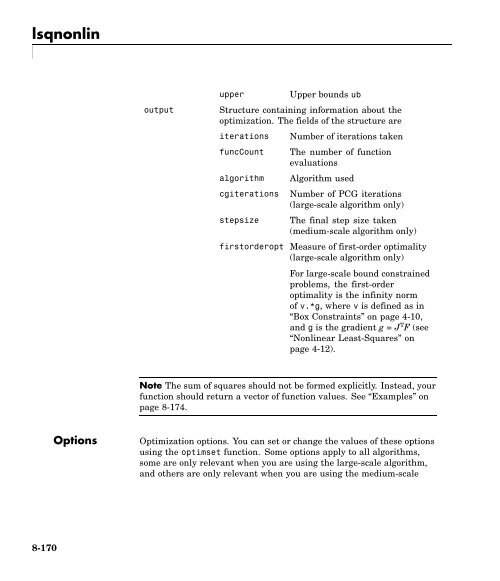What Is Optimization Toolbox?
What Is Optimization Toolbox? What Is Optimization Toolbox?
lsqnonlinoutputupperUpper bounds ubStructure containing information about theoptimization. The fields of the structure areiterationsfuncCountalgorithmcgiterationsstepsizeNumber of iterations takenThe number of functionevaluationsAlgorithm usedNumber of PCG iterations(large-scale algorithm only)The final step size taken(medium-scale algorithm only)firstorderopt Measure of first-order optimality(large-scale algorithm only)For large-scale bound constrainedproblems, the first-orderoptimality is the infinity normof v.*g, wherev is defined as in“Box Constraints” on page 4-10,and g is the gradient g = J T F (see“Nonlinear Least-Squares” onpage 4-12).Note The sum of squares should not be formed explicitly. Instead, yourfunction should return a vector of function values. See “Examples” onpage 8-174.OptionsOptimization options. You can set or change the values of these optionsusing the optimset function. Some options apply to all algorithms,some are only relevant when you are using the large-scale algorithm,and others are only relevant when you are using the medium-scale8-170
lsqnonlinalgorithm. See “Optimization Options” on page 6-8 for detailedinformation.The LargeScale option specifies a preference for which algorithm to use.It is only a preference because certain conditions must be met to use thelarge-scale or medium-scale algorithm. For the large-scale algorithm,the nonlinear system of equations cannot be underdetermined; that is,the number of equations (the number of elements of F returned by fun)must be at least as many as the length of x. Furthermore, only thelarge-scale algorithm handles bound constraints:LargeScaleUse large-scale algorithm if possible when set to 'on'.Use medium-scale algorithm when set to 'off'.Medium-Scale and Large-Scale AlgorithmsTheseoptionsareusedbyboththemedium-scale and large-scalealgorithms:DerivativeCheck Compare user-supplied derivatives (Jacobian) tofinite-differencing derivatives.DiagnosticsDiffMaxChangeDiffMinChangeDisplayDisplay diagnostic information about the functionto be minimized.Maximum change in variables for finitedifferencing.Minimum change in variables for finitedifferencing.Level of display. 'off' displays no output;'iter' displays output at each iteration; 'final'(default) displays just the final output.8-171
- Page 403 and 404: fsolveYoucanformulateandsolvethepro
- Page 405 and 406: fsolveLimitationsThe function to be
- Page 407 and 408: fzeroPurposeSyntaxDescriptionFind r
- Page 409 and 410: fzeroDisplayFunValCheckOutputFcnLev
- Page 411 and 412: fzerowrite an M-file called f.m.fun
- Page 413 and 414: fzmultPurposeSyntaxMultiplication w
- Page 415 and 416: linprogPurposeEquationSolve linear
- Page 417 and 418: linproglambdaoutput-2 No feasible p
- Page 419 and 420: linprogsubject toFirst, enter the c
- Page 421 and 422: linprogDiagnosticsLarge-Scale Optim
- Page 423 and 424: linprogthe primal objective < -1e+1
- Page 425 and 426: lsqcurvefitPurposeEquationSolve non
- Page 427 and 428: lsqcurvefitfunThe function you want
- Page 429 and 430: lsqcurvefitoutputupperUpper bounds
- Page 431 and 432: lsqcurvefitJacobianMaxFunEvalsMaxIt
- Page 433 and 434: lsqcurvefitJacobPatternMaxPCGIterSp
- Page 435 and 436: lsqcurvefitNote that at the time th
- Page 437 and 438: lsqcurvefitof J with many nonzeros,
- Page 439 and 440: lsqlinPurposeEquationSolve constrai
- Page 441 and 442: lsqlinlambdaoutput3 Change in the r
- Page 443 and 444: lsqlinDiagnosticsDisplayMaxIterTypi
- Page 445 and 446: lsqlinPrecondBandWidthUpper bandwid
- Page 447 and 448: lsqlinNotesFor problems with no con
- Page 449 and 450: lsqlinReferences[1] Coleman, T.F. a
- Page 451 and 452: lsqnonlinreturn a vector of values
- Page 453: lsqnonlinOutputArguments“Function
- Page 457 and 458: lsqnonlinJacobMultFunction handle f
- Page 459 and 460: lsqnonlinfor(that is, F should have
- Page 461 and 462: lsqnonlinand Requirements on page 2
- Page 463 and 464: lsqnonnegPurposeEquationSolve nonne
- Page 465 and 466: lsqnonneglambdaoutputVector contain
- Page 467 and 468: optimgetPurposeSyntaxDescriptionExa
- Page 469 and 470: optimsetIn the following lists, val
- Page 471 and 472: optimsetLineSearchType'cubicpoly' |
- Page 473 and 474: optimtoolPurposeSyntaxDescriptionTo
- Page 475 and 476: quadprogPurposeEquationSolve quadra
- Page 477 and 478: quadproglambdaoutput3 Change in the
- Page 479 and 480: quadprogLargeScaleUse large-scale a
- Page 481 and 482: quadprogTolPCGTermination tolerance
- Page 483 and 484: quadprogNotesIn general quadprog lo
- Page 485 and 486: quadprogWhen the equality constrain
- Page 487 and 488: IndexIndex ε-Constraint method 3-4
- Page 489 and 490: Indexinfeasible solution warninglin
- Page 491 and 492: Indexdescriptions 6-8possible value
lsqnonlinoutputupperUpper bounds ubStructure containing information about theoptimization. The fields of the structure areiterationsfuncCountalgorithmcgiterationsstepsizeNumber of iterations takenThe number of functionevaluationsAlgorithm usedNumber of PCG iterations(large-scale algorithm only)The final step size taken(medium-scale algorithm only)firstorderopt Measure of first-order optimality(large-scale algorithm only)For large-scale bound constrainedproblems, the first-orderoptimality is the infinity normof v.*g, wherev is defined as in“Box Constraints” on page 4-10,and g is the gradient g = J T F (see“Nonlinear Least-Squares” onpage 4-12).Note The sum of squares should not be formed explicitly. Instead, yourfunction should return a vector of function values. See “Examples” onpage 8-174.Options<strong>Optimization</strong> options. You can set or change the values of these optionsusing the optimset function. Some options apply to all algorithms,some are only relevant when you are using the large-scale algorithm,and others are only relevant when you are using the medium-scale8-170



